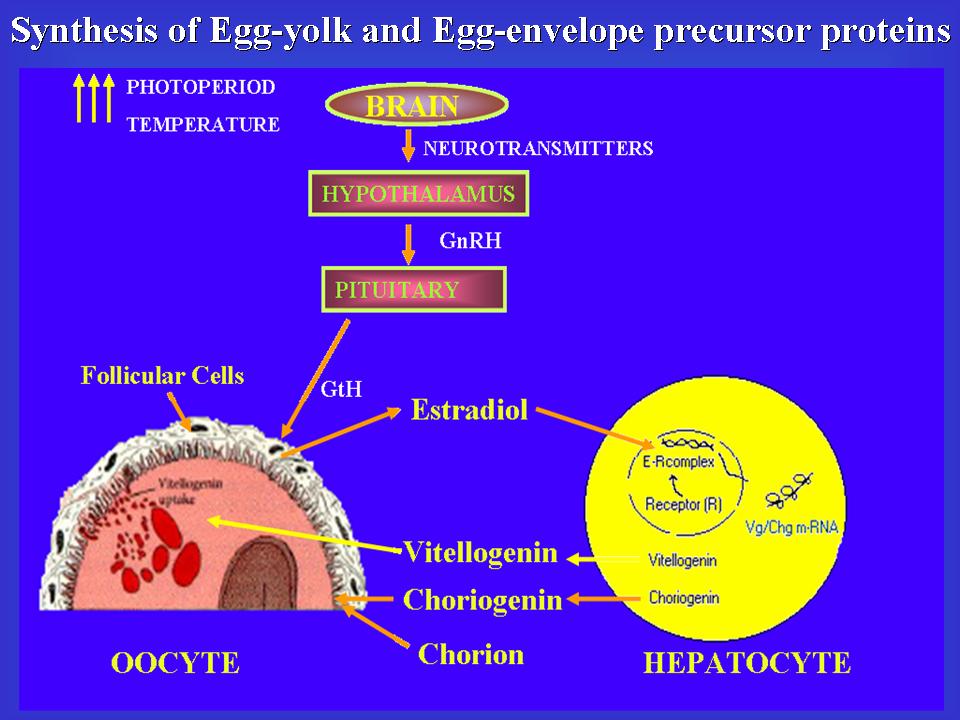User:Omprakash.svc/Vitellogenesis and Choriogenesis in Annual Breeding Fishes
From WikiEducator
Introduction
- Vitellogenesis is the process of preparation of the fishes for the development of the egg so before it can undergo the process of fertilization. The process of vitellogenesis starts well in advance i.e. well before the breeding season. During this process there is several hundred folds increase in the size of the growing oocyte on account of deposition of yolk proteins derived from vitellogenin.
- Vitellogenesis is a highly conserved process all throughout the evolution from invertebrates to vertebrates where the structural structure of Vitellogenin and its function which ensures the embryonic development of the fertilized eggs. Since in oviparous and ovoviviparous fishs there is no link between the mother and the developing embryo the eggs must be prepackaged with the yolk deposits so that the energy can be derived through the breakdown of these proteins during embryogenesis.
- Vitellogenin synthesis in vertebrates is primarily heterosynthetic process, where its synthesis takes place at an extraovarian site and it is then deposited into the developing egg. In other cases the vitellogenin may be synthesized and deposited in the ovary itself, and is known as autosynthetic mode of vitellogenin synthesis.
Environmental and Hormonal Regulation
- The environmental factors (photoperiod, temperature) via hormonal changes in the body of the animal influence the process of vitellogenesis. The fig 1 shows the annual profile of the reproductive/gonad development of the oviparous organisms that are annual breeders. The reproductive cycle can be divided into various phased:
- Preparatory phase: This phase marks the beginning of the reproductive cycle and during this phase the gonad weight is low and starts to increase.
- Prespawning phase: The gonad weight increase sinnificantly and the fishs are ready to undergo the process of fertilization and spawning.
- Spawning phase: During this phase the fishs exhibit mating behaviour and undergo fertilization.
- Post spawning phase: This phase is marked by decrease in the gonad weight on account of release of the eggs from the ovaries for fertilization. This is also known as quiescent phase where there is no sexual recrudescence.
- Preparatory phase: This phase marks the beginning of the reproductive cycle and during this phase the gonad weight is low and starts to increase.
- Figure 2 explains the hypothalamo-pituitary-gonadal control of Vitellogenesis in fishes. During this phase the gonads remain regressed and new gonad cycle starts with the onset of next preparatory phase. During the month of February when the temperature and photoperiod begins to increase, the animals sense the environmental changes by receptors/exteroceptors. This provides the CNS the signal to start the process of gonad development. The brain secretes neurotransmitters which influence hypothalamus the to synthesis and release Gonadotropin secreting hormone (GnRH). This influences the pituitary to release Gonadotrophic hormone (GtH-I)which through blood reaches the gnads. Here it influences the follicular cells of the oocyte/ egg to synthesize estrogen. This estrogen via blood reaches the liver and influence the liver to synthesize vitellogenin. In the liver there are specific Estrogen nuclear receptors and it forms Estrogen-Receptor complex, which initiates the process of transcription of vitellogenin m-RNA followed by translation of vitellogenin. This vitellogenin peptide undergoes post translational modifications such as glycosidation, lipidation and physphorylation to form a complex glycolipophospho protein. This is released in the blood and reaches the gonad where it is sequestered into the growing oocyte by receptor mediated endocytosis. The process is accomplished successfully only in the presence of GtH-I. Inside the oocyte it is broken into various components in the egg which provides energy (Phosvitin: phosphorus rich moiety) and nutrition (lipovitellin: lipid rich moiety) to the developing embryo after fertilization.
- This process continues for months in the annual oviparous breeders. By the end of this process the eggs are fully laden with yolk-proteins, but another environmental factor plays an important role towards the reproductive success. The process of fertilization does not take place until the fishs perceive a change in an environmental factor i.e. heavy rainfall in the form of monsoon. The rainfall serve at a trigger mechanism for the fish pituitary to release maturational inducing steroid (MIS:17α, 20β Di-hydroxy-progesterone) also called as GtH-II, which is responsible for fertilization and spawning behavior in the fishes (release of eggs and sperms). The continuous monsoon rainfall brings about physico-chemical changes in the water like there is alteration in pH on account increase in the influx of ions and increase in the turbidity. These changes in the water are sensed by the receptors of the fish and this stimulates the fish to release the gonatotrophic hormone (GtH-II) which it synthesized and remains stored in the pituitary. This hormone through blood reaches the gonads and bring about the mating behavior in the fishs and leads to spawning followed ;by fertilization. In the absence of the monsoon trigger the fish does not undergo spawning and the gonads undergo self atresia.
Choriogenesis
- It is not only this process of Vitellogenesis i.e. synthesis and incorporation of precursor protein vitellogenin but also the process of incorporation of another protein choriogenin around the egg that plays an important role for the success of reproduction. Like vitellogenin, Choriogenin is also synthesized in liver under the influence of circulating estrogen and is controlled by hypothallamo-pituitary-gonadal pathway and it gets incorporated around the egg. Its is virtually impossible for the egg to incorporate such large quantities of yolk-proteins until the membrane also increases in size. This process which involves the synthesis and deposition of Crorion protein around the growing oocyte is called CHORIOGENESIS.
- This egg membrane is variously named as chorion. Egg envelope or zona radiate and plays pivotal roles:
- During egg development it helps in incorporation of egg proteins as all the material is sequesteres through the pores present in the membrane. During fertilization it prevents poly-sperms and after fertilization this membrane undergoes modifications to form a hard gelatinous mass which provide a suitable microenvironment to the developing embryo. It protects the embryo against mechanical and chemical hazards.

